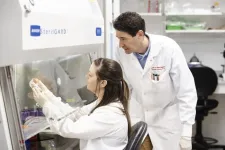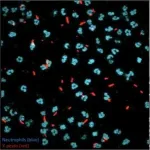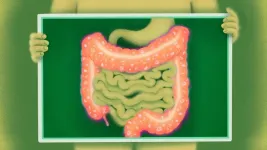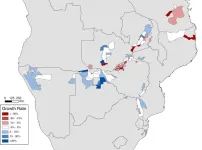(Press-News.org) When the body encounters bacteria, viruses or harmful substances, its innate immune cells, neutrophils, assemble at the site to combat the invader.
Bacteria and viruses have ways to avoid these defenses, however. Yersinia pestis, the bacteria that causes bubonic and pneumonic plague, for example, can hide from the immune system, allowing it to replicate in the body unhindered until it can overwhelm the host. This ability allowed Y. pestis to spread bubonic plague across Europe in the 14th Century, killing a third of the European population.
While plague may not be a serious threat to human health in modern times, researchers at the University of Louisville are studying Y. pestis to better understand its ability to evade the immune system and apply that understanding to control other pathogens.
“If you look at human plague, people don’t show symptoms right away even though they have an active infection because the bacteria is hiding from the immune system. Then all of a sudden there is a lot of bacteria, the immune system is overwhelmed and in the case of pneumonic plague, the individual dies from pneumonia,” said Matthew Lawrenz, professor in the UofL Department of Microbiology and Immunology.
Neutrophils are the immune system’s first responders, sending out protein molecules to summon other neutrophils to attack and destroy the invader. Among the first molecules sent out by neutrophils to signal an infection are Leukotriene B4 (LTB4) lipid molecules. Y. pestis interferes with the immune response by suppressing the LTB4 signals. Lawrenz has received a new $2.9 million, four-year grant from the National Institutes of Health to investigate how Y. pestis blocks LTB4. Ultimately, he expects this understanding will lead to ways to prevent Y. pestis from blocking the signals and hopefully, apply that understanding to other types of infections.
“This historic pathogen is really good at manipulating the immune system, so we use it as a tool to better understand how white blood cells like neutrophils and macrophages respond to bacterial infection,” Lawrenz said. “In this project, we are using Yersinia to better understand why LTB4 is so important to controlling plague. This understanding would apply to almost any infection of the lungs or other areas, and it probably could apply to viruses also.”
A member of the UofL Center for Predictive Medicine for Biodefense and Emerging Infectious Diseases, Lawrenz has been studying plague bacteria for nearly two decades. His previous work includes discoveries of how Y. pestis acquires iron and zinc to overcome a host’s defense mechanism known as nutritional immunity and has increased understanding of how Y. pestis inhabits spaces within host macrophages to hide from the immune system.
Katelyn Sheneman, a doctoral student in Lawrenz’s lab, also has received a prestigious $100,000 research award for trainees from the NIH. This grant will fund her research to understand how Y. pestis changes the contents of extracellular vesicles, cellular containers produced by immune cells that contain proteins, lipids such as LTB4 and other components. These vesicles are released into the bloodstream to communicate to other cells what is happening in their part of the body, such as an infection.
“My project is looking at how Y. pestis alters the number of vesicles being produced, what is being packaged in them and how other cells are responding to them,” Sheneman said. “We have some good evidence that pestis is able to manipulate the production of these vesicles, so we are going to look at the role the vesicles play in pulmonary infection and how that influence contributes to overall systemic infection.”
Since there is no effective vaccine against infection by Y. pestis and it has the potential to be used as a bioweapon, Lawrenz and Sheneman study Y. pestis in UofL’s Biosafety Level 3 facilities at the Regional Biocontainment Laboratory, part of a network of 12 regional and 2 national biocontainment laboratories for studying infectious agents. Biosafety Level 3 facilities are built to exacting federal safety and security standards in order to protect researchers and the public from exposure to the pathogens being investigated.
END
UofL researchers are unmasking an old foe’s tricks to thwart new diseases
Research team awarded grants for further research on plague-causing bacteria
2024-01-05
ELSE PRESS RELEASES FROM THIS DATE:
Soil fungi may help explain the global gradient in forest diversity
2024-01-05
A paper published in Nature Communications Biology contributes to the growing appreciation for the outsize role that microbes play in everything from human digestion to crop yields: Microbes in the soil—fungi in this case—appear to be influencing forest diversity on a global scale.
Forests on Earth exhibit a marked gradient from the equator toward the poles: Tropical forests near the equator tend to include a large number of different species, whereas forests nearer the poles support less plant diversity.
One explanation for this phenomenon maintains that soil pathogens, including bacteria and fungi, help create this gradient. ...
UC Davis Health creates road map to diversify health care workforce
2024-01-05
How can health care systems increase diversity and inclusion in their workforce?
UC Davis Health, recognized by Forbes as a "Best Employer in California", has developed a road map for increasing workforce diversity across the industry. While California banned the consideration of race or ethnicity in hiring at public institutions in 1996, UC Davis Health has since come up with a holistic outreach and local recruitment plan that has proven effective. And that approach is now receiving global attention through a new case study published in New England Journal ...
PTSD, depression, and anxiety nearly doubles in Israel in aftermath of Hamas attack
2024-01-05
A study conducted by researchers at Ruppin Academic Center in Israel and Columbia University documents the broad impact on the mental health of Israelis, both Jews and Arabs, with sharp increases in post-traumatic stress disorder (PTSD), depression, and anxiety in the aftermath Hamas' attack in October.
The study, published in the Lancet’s EClinicalMedicine Jan. 5, 2023, found the prevalence of probable PTSD, depression, and anxiety in the weeks following the attacks (29% for PTSD, ...
When bad cells go good: Harnessing cellular cannibalism for cancer treatment
2024-01-05
(Santa Barbara, Calif.) — Scientists have solved a cellular murder mystery nearly 25 years after the case went cold. Following a trail of evidence from fruit flies to mice to humans revealed that cannibalistic cells likely cause a rare human immunodeficiency. Now the discovery shows promise for enhancing an up-and-coming cancer treatment.
“This paper takes us from very fundamental cell biology in a fly, to explaining a human disease and harnessing that knowledge for a cancer therapy,” ...
Researchers identify why cancer immunotherapy can cause colitis
2024-01-05
Researchers at the University of Michigan Health Rogel Cancer Center have identified a mechanism that causes severe gastrointestinal problems with immune-based cancer treatment.
They also found a way to deliver immunotherapy’s cancer-killing impact without the unwelcome side effect.
The findings are published in Science.
“This is a good example of how understanding a mechanism helps you to develop an alternative therapy that’s more beneficial. Once we identified the mechanism causing the colitis, we could then develop ways to overcome this problem and prevent colitis while preserving the anti-tumor effect,” said senior ...
JNM publishes procedure standard/practice guideline for FES PET imaging of breast cancer
2024-01-05
Reston, VA — The Society of Nuclear Medicine and Molecular Imaging (SNMMI) and the European Association of Nuclear Medicine (EANM) have issued a new procedure standard/practice guideline for estrogen receptor imaging of breast cancer patients using FES PET. The standard/guideline, published ahead of print in The Journal of Nuclear Medicine, is intended to assist physicians in recommending, performing, interpreting, and reporting the results of 18F-FES PET studies for patients with breast cancer.
More than two million women worldwide are diagnosed with breast cancer ...
Can we fight back against Parkinson’s disease? These research volunteers hope so
2024-01-05
About three years before he retired, David Campbell noticed something weird happening as he typed. Whenever he tried to hit a letter, say “a,” he’d get “aaa,” like the keyboard was jamming or his finger was triple-tapping the key. That wasn’t the only thing that seemed off—his sense of smell was faltering. “Little things,” he says, “that I didn’t think of as being a big deal.”
A couple of weeks after he retired in fall 2020, Campbell learned the little things weren’t ...
After COP28 “insider” climate activists will become increasingly important, study suggests.
2024-01-05
Climate campaigners will increasingly adopt “insider activist” roles, working to change or challenge their organisations from the inside rather than the outside, a new study says.
Research led by the University of Exeter identifies different types of climate activists. As well as “insiders”, there are others who seek to undermine, or even damage, climate-recalcitrant organisations they are members of in the hope of change.
The study says the growing climate backlash against traditional outside climate activism and rise of corporate “greenwashing” means collaborating or ...
Protected areas for elephants work best if they are connected
2024-01-05
PRETORIA, SOUTH AFRICA – Conservation measures have successfully stopped declines in the African savanna elephant population across southern Africa, but the pattern varies locally, according to a new study.
The evidence suggests that the long-term solution to elephant survival requires not only that areas are protected but that they are also connected to allow populations to stabilize naturally, an international research team says.
Their study, published on January 5th in the peer-reviewed journal Science Advances, collected survey estimates and calculated growth rates for ...
Cult mentality: SLU professor makes monumental discovery in Italy
2024-01-05
Douglas Boin, Ph.D., a professor of history at Saint Louis University, made a major announcement at the annual meeting of the Archeological Institute of America, revealing he and his team discovered an ancient Roman temple that adds significant insights into the social change from pagan gods to Christianity within the Roman Empire.
“We found three walls of a monumental structure that evidence suggests belonged to a Roman temple that dates to Constantine's period,” Boin said. “It dates to the fourth century AD and it would ...
LAST 30 PRESS RELEASES:
ASH 2025: AI uncovers how DNA architecture failures trigger blood cancer
ASH 2025: New study shows that patients can safely receive stem cell transplants from mismatched, unrelated donors
Protective regimen allows successful stem cell transplant even without close genetic match between donor and recipient
Continuous and fixed-duration treatments result in similar outcomes for CLL
Measurable residual disease shows strong potential as an early indicator of survival in patients with acute myeloid leukemia
Chemotherapy and radiation are comparable as pre-transplant conditioning for patients with b-acute lymphoblastic leukemia who have no measurable residual disease
Roughly one-third of families with children being treated for leukemia struggle to pay living expenses
Quality improvement project results in increased screening and treatment for iron deficiency in pregnancy
IV iron improves survival, increases hemoglobin in hospitalized patients with iron-deficiency anemia and an acute infection
Black patients with acute myeloid leukemia are younger at diagnosis and experience poorer survival outcomes than White patients
Emergency departments fall short on delivering timely treatment for sickle cell pain
Study shows no clear evidence of harm from hydroxyurea use during pregnancy
Long-term outlook is positive for most after hematopoietic cell transplant for sickle cell disease
Study offers real-world data on commercial implementation of gene therapies for sickle cell disease and beta thalassemia
Early results suggest exa-cel gene therapy works well in children
NTIDE: Disability employment holds steady after data hiatus
Social lives of viruses affect antiviral resistance
Dose of psilocybin, dash of rabies point to treatment for depression
Helping health care providers navigate social, political, and legal barriers to patient care
Barrow Neurological Institute, University of Calgary study urges “major change” to migraine treatment in Emergency Departments
Using smartphones to improve disaster search and rescue
Robust new photocatalyst paves the way for cleaner hydrogen peroxide production and greener chemical manufacturing
Ultrafast material captures toxic PFAS at record speed and capacity
Plant phenolic acids supercharge old antibiotics against multidrug resistant E. coli
UNC-Chapel Hill study shows AI can dramatically speed up digitizing natural history collections
OYE Therapeutics closes $5M convertible note round, advancing toward clinical development
Membrane ‘neighborhood’ helps transporter protein regulate cell signaling
Naval aviator turned NPS doctoral student earns national recognition for applied quantum research
Astronomers watch stars explode in real time through new images
Carbon-negative building material developed at Worcester Polytechnic Institute published in matter
[Press-News.org] UofL researchers are unmasking an old foe’s tricks to thwart new diseasesResearch team awarded grants for further research on plague-causing bacteria





